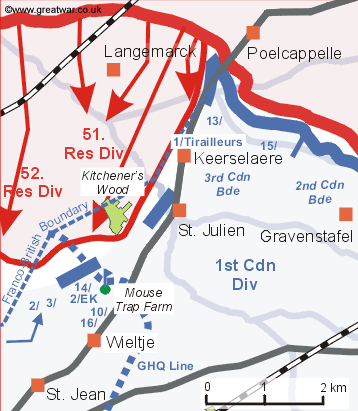 3rd Canadian Brigade to organise a counter-attack at Kitchener's Wood
3rd Canadian Brigade to organise a counter-attack at Kitchener's Wood
22 April 1915: 22.00
Already at 6.30pm the 3rd Brigade had been warned to prepare for orders to make a counter-attack. At 7.30pm the 3rd Brigade had informed 1st Canadian Division that it only had one battalion available for a counter-attack. This was the 14th Canadian Battalion presently in Brigade Reserve, which had moved into a position near the 3rd Brigade headquarters in Mouse Trap Farm from about 6pm. 3rd Brigade HQ did not believe an attack with only one battalion could be very effective in the face of the superior numbers of advancing German troops.
Nevertheless, one hour and twenty minutes later at 8.52pm, in response to the French request for British support for their counter-attack towards Pilckem at 8pm(1), the 3rd Canadian Brigade received instructions (sent from 1st Canadian Division headquarters at about 8pm) that it was to make a counter-attack towards the oak wood known as Kitchener's Wood(2). According to the British Official History the wood was “a most dangerous locality to leave in enemy hands” (3); it lay about 900 metres west of St. Julien on the nearly flat forward slope of Mouse Trap Ridge. The Germans had unseen access into it from the north.
Reinforcements to Support 3rd Brigade Delayed

The 3rd Brigade was told to expect the 2nd Battalion and 3rd Battalion of 1st Canadian Brigade (from the Second Army Reserve) to report to its headquarters at Mouse Trap Farm as reinforcements.(4) At 8.30pm these two battalions had been ordered by the 1st Canadian Division commander, General Alderson, to move off immediately from Vlamertinghe. However, they had not arrived at Mouse Trap Farm by 10pm. General Alderson's original message does not appear to have been received by them, as it was repeated at 9.45pm and was noted as received on the second attempt to send it by 1st Canadian Brigade at 9.50pm.
Owing to the subsequent delayed arrival of these two battalions they were not detailed to take part in the counter-attack. They were ordered instead to fill the gap between the Canadians and the French on the left of 3rd Brigade and north of Wieltje.
3rd Brigade was also informed that a battalion of the British 28th Division, namely 2nd Battalion East Kent Regiment (the Buffs) under Colonel Geddes, was also coming to their support. By 10pm this battalion had not yet reported to 3rd Brigade headquarters at Mouse Trap Farm.
But the commander of 3rd Brigade, Brigadier-General Turner, did confirm that both 10th and 16th Canadian Battalions had now arrived in his sector and he intended to make the counter-attack with them.(5)
By 11pm one company of the Buffs had reported to 3rd Brigade and this was ordered to hold the line from St. Julien to Mouse Trap Farm. Another company followed and was sent to report to 13th Battalion holding the new front line established along the St.Julien-Poelcappelle road.
Situation in the Front Line
The situation for the French on the left of the Canadians was that they had fallen behind the G.H.Q. Line and had asked the Canadians for help. The Germans had begun to attack the French in the Langemarck-Keerselaere sector again. Brigadier-General Turner sent the French soldiers who had stayed in the line with the Canadians over to help them.
According to the Field Messages sent by 3rd Brigade(6), the situation in the line for the British was:
- 13th Battalion had lost touch with the French on their left due to the French retirement
- reserves in St. Julien consisted of about 300 men in trenches in front of the village.
Next>> Canadians to counter-attack at 11.30pm
Acknowledgements & Notes
(1) Kitchener's Wood: See the page British heavy guns captured in Kitchener's Wood
(2) Official History of the Canadian Forces in The Great War 1914-1919, Volume I, Chronology, Appendices and Maps, Appendix no. 375, p. 243. See also Gravenstafel Ridge Phase I: A French counter-attack from Boesinghe
Kitchener's Wood: see the page British heavy guns captured in Kitchener's Wood
(3) British Military Operations: France and Belgium, 1915, footnote p. 185
(4) see the page Response of Second British Army headquarters to the German attack
(5) Official History of the Canadian Forces in The Great War 1914-1919, Volume I, Chronology, Appendices and Maps, Appendix no. 383, p. 244
(6) Official History of the Canadian Forces in The Great War 1914-1919, Volume I, Chronology, Appendices and Maps, Appendix no. 387 and 388, p. 245